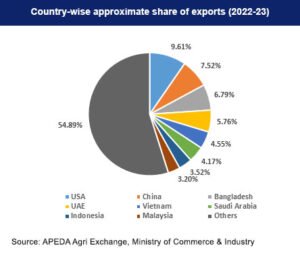India’s exports of agricultural products, including basmati rice, decreased to 17.93 lakh tonnes in September of this year from 27.94 lakh tonnes the month before, according to agri-export promotion organization APEDA.
Agri-commodity exports in both April and May were about 33 lakh tonnes. However, because of many restrictions on the export of different types of rice, such as broken rice and non-basmati white rice, shipments of agricultural products decreased to around 18 lakh tonnes.
In August of the 2023–24 fiscal year, exports of agricultural products were 27.94 lakh tons, according per the records kept by the Agricultural and Processed Food Products Export Development Authority (APEDA).
Value-wise, agricultural exports fell from Rs 18,128 crore in August of this fiscal year to Rs 14,153 crore in September.
According to the report, a significant portion of September’s exports were non-basmati goods, which totaled 4.25 lakh tonnes, basmati rice (1.21 lakh tonnes), fresh onions (1.51 lakh tonnes), and buffalo meat (1,21,427 tonnes).
A total of 172.27 lakh tonnes of agricultural products were exported between April and September.
The ban on some types of rice and the establishment of a minimum export price on basmati rice to increase domestic supply and control food inflation have impacted the export of some agricultural goods this year.
APEDA keeps records on the export of 47 agricultural products, such as items made from beef and poultry.
Controlling exports won’t address the underlying issues in Indian agriculture
India celebrated a record-breaking year for agricultural exports in April 2023, surpassing US$42 billion the year before. This export level was over 48% higher than the pre-pandemic record set in 2018–2019.
While sugar exports were more than 25% higher than the previous year, rice and pulse exports had climbed by more than 15% and 84%, respectively. These encouraging indicators were considered a significant step toward the 2018 National Agriculture Export Policy’s implementation.
The government implemented a 20% export tariff on parboiled rice in August 2023, severely limiting rice exports. In response to a reduction in the nation’s wheat production during the 2022–2023 crop season, the government tightened controls on cereal prices, which increased by more than 8% annually. This was due to a tightening supply of main food grains generally.
The government’s decision to impose export restrictions was also influenced by high domestic pricing for other agricultural commodities.
In August 2023, onion prices climbed by 31%, and in September, they jumped by more than 55%. As a result, the government established a minimum export price of US$800 per metric ton, which would remain in place until the end of August, and levied a 40% export tax till end of 2023.
In the same manner, sugar mills were only permitted to export 6.2 million metric tons of sugar for the season that ends on September 30, 2023. Originally set to expire on October 31, 2023, the limit has now been extended indefinitely.
In contrast, the government did not implement any export limits to alleviate shortages in domestic supplies, even though the price of pulses increased by 17% in September. Rather, it approved the export of more than 2 million tons of vital types, such as pigeon peas and lentils, in order to stabilize the market for these goods.
Export curb an unnecessary barrier for India ?
The targeted agricultural commodities’ worldwide prices increased significantly as a result of India’s attempts to limit their exports. Between June and September 2023, the world’s rice prices jumped by almost 25% due to the largest rice supplier pulling out of the global market, while sugar prices reached an all-time high.
The main export markets for India are worried about runaway pricing that can arise from export limitations, especially those in its immediate vicinity.
India has faced criticism from a number of developed nations for its abrupt export reduction measures.
At the World Trade Organization Committee on Agriculture conference in September 2023, a delegation of nine nations, led by the United States, noted that India’s export ban and its negative effects on import-dependent nations.
They believed that in such unstable economic circumstances, the afflicted countries would be vulnerable to food shortages.
The United States demanded that India immediately remove its export ban on non-basmati rice, citing it as an “unnecessary trade barrier.” The US Department of Agriculture’s forecast that India would likely set a record for rice output in 2023–2024 with 134 million tons was the basis for the US government’s criticism.
However, it was later revealed in the US Department of Agriculture’s Rice Outlook that India’s rice production was expected to decline by 4 million tons in 2023–2024.
There are valid reasons why the Indian government has put export limits in place, but it is crucial to look into ways to avert a world food crisis. India must make sure that the unpredictability of its agricultural output is effectively addressed.
India’s agricultural sector has several challenges, chief among them being severe underinvestment. Reviving the long-abandoned concept of setting up regional food banks is important in order to meet the food import demands of net-importing nations during periods of shortage.














Comments 3